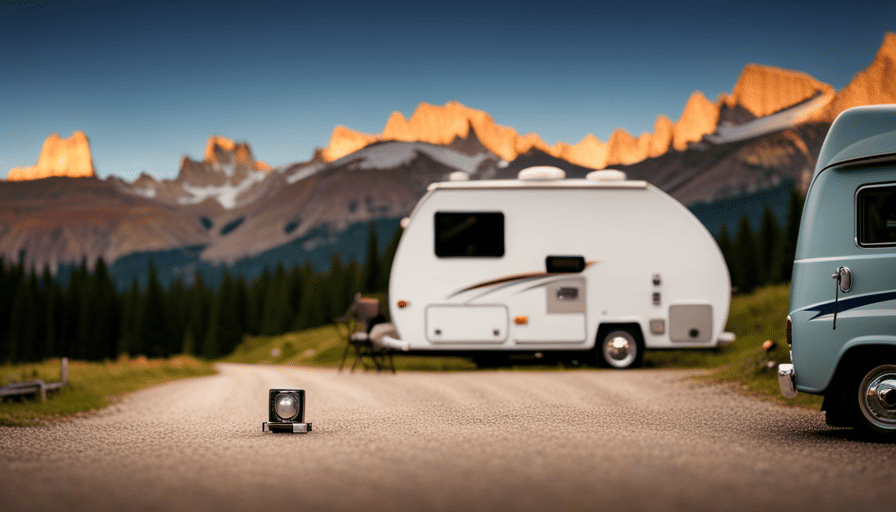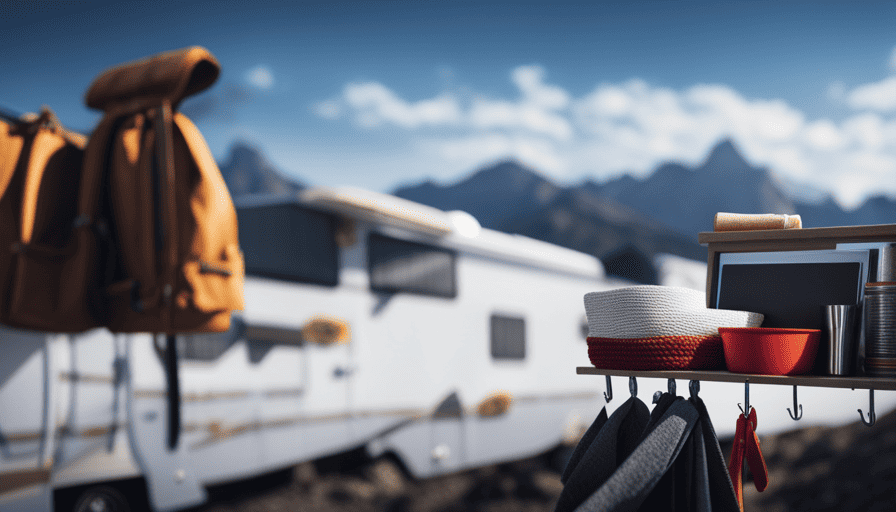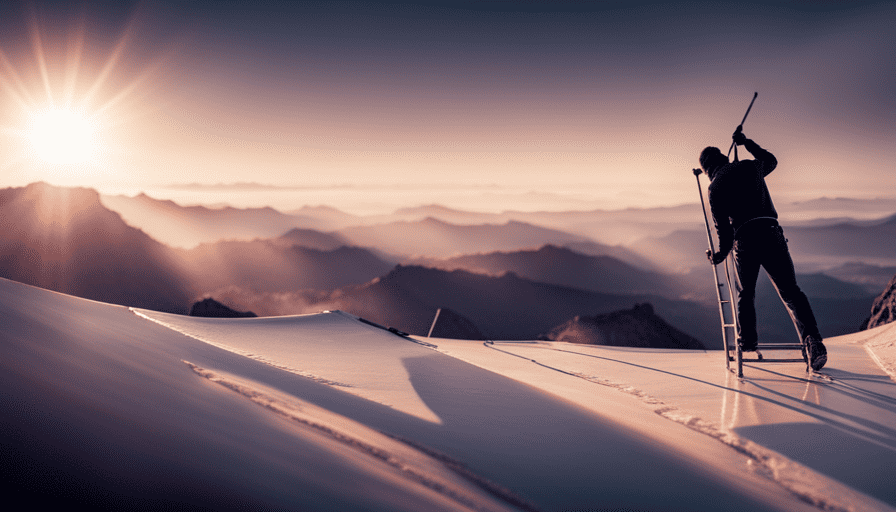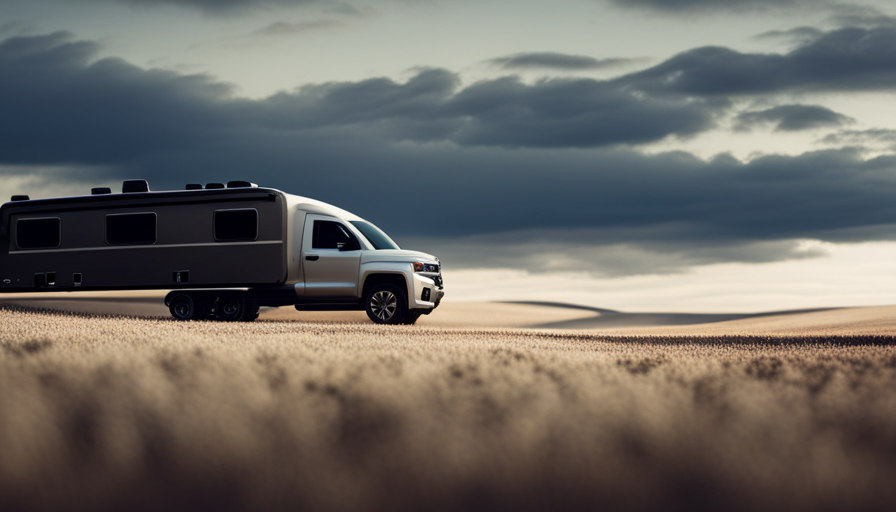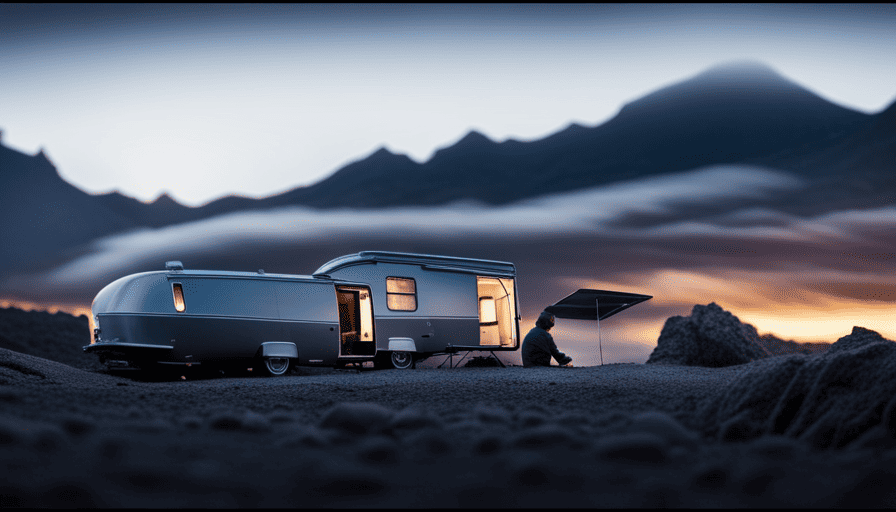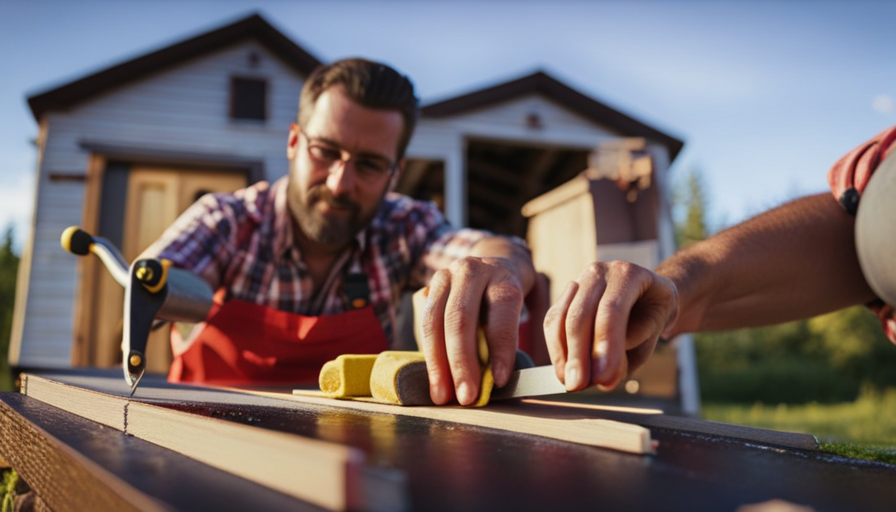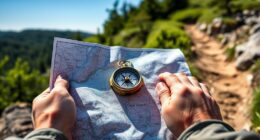Backing up a camper may appear daunting initially, but with the right techniques and a bit of practice, it can become second nature.
In this article, I will share some practical tips and strategies that will help you master the art of backing up your camper with ease. We’ll explore everything from understanding your camper’s dimensions and turning radius to utilizing technology tools like back-up cameras and sensors. I will also provide some advice on practicing in a safe and open area before attempting to back up in a more challenging location. Additionally, we’ll discuss the importance of having a spotter to help guide you as you maneuver your camper into position. These tips and tricks will not only make your camping trips more enjoyable, but they’ll also come in handy if you ever find yourself selling a used camper.
I’ll also provide guidance on how to choose the best route and parking spot, and how to be mindful of obstacles and surroundings. Plus, I’ll address the importance of taking it slow and steady, and not being afraid to ask for help or take breaks when needed.
So, whether you’re a seasoned camper or a newbie, this article will equip you with the knowledge and confidence to successfully navigate those tight spots and tricky situations when backing up your camper.
Key Takeaways
- Understand your camper’s dimensions and turning radius
- Utilize technology tools like back-up cameras and sensors
- Choose the best route and parking spot, be mindful of obstacles
- Take it slow and steady, ask for help, and take breaks when needed
Understand Your Camper’s Dimensions and Turning Radius
To successfully back up your camper, you need to understand its dimensions and turning radius. Camper dimensions can vary greatly depending on the make and model, so it’s important to know the exact measurements of your camper before attempting to maneuver it in tight spaces. This will help you determine how much clearance you have and avoid potential obstacles. Additionally, understanding the turning radius of your camper will give you a better sense of how much space you need to make a successful turn. Once you have a good grasp of these factors, you can confidently navigate your camper into a parking spot or camping site with ease. As a further tip, connecting solar panels to camper can provide you with a sustainable power source while on the road or at your destination.
Additionally, understanding your camper’s turning radius is crucial for navigating corners and making sharp turns. Larger campers may have a wider turning radius, which means you’ll need to allow for more space when making maneuvers.
Maneuvering challenges can arise when backing up a camper, especially in tight or crowded areas. It’s important to be aware of your surroundings and take extra caution when maneuvering your camper. Safety precautions should always be a top priority. This includes checking for obstacles, such as trees or other vehicles, before attempting to back up. It’s also a good idea to have a spotter outside the camper to guide you and provide assistance if needed.
In order to effectively back up your camper, you’ll need to use your mirrors and cameras effectively. These tools can greatly enhance your visibility and help you navigate with confidence. By adjusting your mirrors to provide a clear view of the camper and its surroundings, you’ll be able to make more accurate maneuvers. Cameras, such as a rearview or backup camera, can also be extremely helpful in providing additional visibility.
By utilizing these tools and taking the time to understand your camper’s dimensions and turning radius, you’ll be well-equipped to navigate any backing up situation with ease.
Use Your Mirrors and Cameras Effectively
Using your mirrors and cameras effectively is like having an extra set of eyes on the road. When it comes to backing up a camper, these tools are absolutely essential for ensuring a safe and successful maneuver.
Start by adjusting your side mirrors so that you have a clear view of the area behind your camper. Make sure they’re angled properly to eliminate blind spots. Utilize your rearview mirror as well to get a comprehensive picture of what’s happening behind you.
In addition to mirrors, take advantage of the technology tools available to you. Many campers come equipped with backup cameras that provide a live feed of what’s happening behind your camper. These cameras can greatly enhance your visibility and make it easier to navigate tight spaces. Pay close attention to the screen and use it in conjunction with your mirrors to get a complete understanding of your surroundings.
By using mirrors effectively and utilizing technology tools, you can greatly reduce the risk of accidents and damage while backing up your camper. These tools provide valuable information that you can use to make informed decisions and avoid potential hazards.
Practice in an open space before hitting the road to further refine your skills and build confidence in your abilities.
Practice in an Open Space Before Hitting the Road
Before taking your camper on the road, it’s important to find an open space where you can practice maneuvering and build your confidence. Practicing in an open space allows you to familiarize yourself with the size and weight of your camper, as well as get comfortable with backing up in different weather conditions.
It’s crucial to practice in various weather conditions because each one can affect the handling and traction of your camper differently. By practicing in rain, wind, or snow, you’ll gain the experience needed to safely navigate these conditions when you’re on the road.
Additionally, it’s essential to practice backing up on uneven terrain or inclines. These situations can be challenging, especially for beginners, but with practice, you’ll learn how to adjust your steering and throttle to maneuver your camper smoothly. When backing up on uneven terrain, it’s important to be cautious and go slow to avoid any damage to your camper or the environment.
By practicing in an open space and mastering backing up in different weather conditions and on varying terrains, you’ll become more confident in handling your camper. This confidence will be invaluable when you eventually hit the road.
In the next section, we’ll discuss the importance of using a spotter for guidance, which can further enhance your backing up skills without the need for specific steps.
Use a Spotter for Guidance
Having a spotter by your side can greatly enhance your maneuvering skills and provide you with the guidance you need to confidently navigate tricky situations. The spotter’s role is to stand outside the camper and communicate with the driver using hand signals or a walkie-talkie. This ensures clear communication and prevents any misunderstandings.
To better understand the spotter’s role, let’s take a look at this table:
| Spotter’s Role | Alternative Methods |
|---|---|
| Guides the driver | Rearview camera |
| Assists with backing up | Mirrors |
| Alerts the driver of obstacles | Backup sensors |
| Communicates using hand signals | Backup cameras |
| Provides directions and feedback | GPS system |
While technology like rearview cameras, mirrors, backup sensors, and cameras can be helpful, they may not provide the same level of accuracy and real-time feedback as a spotter. A spotter can provide immediate guidance and can adjust their instructions based on the situation.
With the spotter’s assistance, you can confidently back up your camper, ensuring that you avoid obstacles and park in tight spaces. Remember to take it slow and steady, maintaining clear communication with your spotter. This will allow you to smoothly transition into the subsequent section about ‘take it slow and steady’ without writing ‘step’.
Take It Slow and Steady
Don’t rush the process and enjoy the leisurely pace of maneuvering your cozy home on wheels. When it comes to backing up a camper, taking it slow and steady is key. Rushing can lead to costly mistakes and unnecessary stress.
To ensure a smooth and successful backup, it’s important to practice techniques and be aware of common mistakes.
First and foremost, always use a spotter for guidance. They can provide you with valuable information about obstacles and help you navigate tight spaces. Trust their directions and communicate clearly with them throughout the process.
Next, take your time and use small, incremental movements. Avoid making sudden or jerky motions, as this can throw off your alignment and make it difficult to correct your course. Remember, it’s better to make small adjustments than to have to start over from scratch.
One common mistake is relying solely on your mirrors. While they’re helpful, they can also create blind spots. To overcome this, use hand signals and clear communication with your spotter. This will ensure that you’re both on the same page and can work together seamlessly.
As you practice these techniques and become more comfortable, backing up your camper will become second nature. So, take it slow, enjoy the process, and get ready to learn about the importance of using hand signals and clear communication in the next section.
Use Hand Signals and Clear Communication
Ensure a smooth and successful maneuver by mastering the art of using hand signals and clear communication with your spotter while navigating your cozy home on wheels.
When it comes to backing up your camper, the importance of hand signals cannot be overstated. These signals allow you to communicate with your spotter effectively and ensure that you are both on the same page. Hand signals eliminate the need for shouting or relying solely on mirrors, which can sometimes be unreliable.
To begin, establish a set of hand signals that you and your spotter will use consistently. This will help you establish a clear line of communication and prevent any confusion. For example, you can agree that a closed fist means stop, a thumbs-up means go forward, and a sweeping motion with your hand means to turn. Practice these signals before hitting the road to ensure that both you and your spotter are familiar with them.
During the backing up process, maintain eye contact with your spotter and rely on their signals. This will help you stay focused and ensure that you are both working together as a team. Remember, clear communication is key to a successful backup.
Now, as we transition into the next section about utilizing technology tools, such as back-up cameras and sensors, it’s important to note that while these tools can be helpful, they shouldn’t replace the use of hand signals and clear communication. These tools can provide an additional layer of assistance, but they should always be used in conjunction with proper communication techniques.
Utilize Technology Tools, such as Back-Up Cameras and Sensors
Using technology tools like back-up cameras and sensors can enhance your maneuvering skills and provide an added sense of security while navigating your mobile home. Integrating technology in camper backup has numerous benefits, making the process easier and safer. Here are three reasons why you should consider using back-up cameras and sensors:
-
Improved visibility: Back-up cameras give you a clear view of what’s behind your camper, eliminating blind spots and allowing you to see obstacles or people that might be in your way. This enhanced visibility greatly reduces the risk of accidents while maneuvering in tight spaces.
-
Distance measurement: Some back-up cameras and sensors come with distance measurement features, helping you estimate the distance between your camper and any obstacles. This is especially useful when parking in crowded campgrounds or tight parking spots, ensuring you can safely and accurately position your camper.
-
Ease of use: Back-up cameras and sensors are easy to install and use. They provide real-time video feed or audible alerts, giving you instant feedback on your surroundings. This allows you to make precise adjustments and eliminates the guesswork involved in backing up your camper.
By utilizing technology tools like back-up cameras and sensors, you can greatly enhance your maneuvering skills and ensure a smoother and safer camping experience. Once you’ve mastered using these tools, the next step is to plan your route and parking in advance.
Plan Your Route and Parking in Advance
Before embarking on your camping adventure, it’s essential to map out your route and secure a suitable parking spot in advance. Planning your stops along the way will not only help you stay organized, but it will also ensure that you have enough time to relax and enjoy the journey.
Researching parking options ahead of time is crucial, especially if you’re traveling to popular camping destinations or during peak seasons.
When planning your route, consider the distance you’ll be traveling each day and the amenities you’ll need along the way. Look for campgrounds or RV parks that offer convenient facilities like water and electric hookups, dump stations, and nearby attractions. Online resources, such as camping websites and apps, can provide valuable information and reviews from fellow campers.
In addition to finding suitable parking spots, it’s important to be mindful of obstacles and surroundings while backing up your camper. Always check your surroundings for any low-hanging tree branches, rocks, or other potential hazards that could damage your camper. Make sure to use your mirrors and back-up camera, if available, to get a clear view of the area behind you.
By planning your route and researching parking options in advance, you’ll have a smoother and more enjoyable camping experience. Now, let’s move on to the next section and discuss how to be mindful of obstacles and surroundings while backing up your camper.
Be Mindful of Obstacles and Surroundings
While planning your camping adventure, it’s crucial to keep an eye out for any unexpected obstacles and surroundings that could pose a threat to your camper. Obstacle avoidance and spatial awareness are essential skills to ensure a safe and hassle-free journey. Here are some tips to help you navigate through potential challenges:
-
Clear the path: Before backing up your camper, make sure the area behind you is clear of any obstacles such as rocks, branches, or other campers. This will prevent any damage to your vehicle or surroundings.
-
Check your blind spots: Use your mirrors and rearview camera to check for any blind spots. Be aware of pedestrians, animals, or low-hanging branches that might be out of your sight.
-
Watch for dips and inclines: Pay attention to the terrain and avoid backing up on steep inclines or into deep ditches. These can cause your camper to tip or get stuck, leading to potential damage.
-
Slow and steady: Take your time when backing up. Use small adjustments and gentle movements to ensure precision and avoid any sudden movements that could lead to accidents.
As you become more skilled at obstacle avoidance and spatial awareness, you’ll gain confidence in maneuvering your camper. Remember, don’t be afraid to ask for help or take breaks if you need them.
Transitioning into the next section, let’s explore the importance of seeking assistance and taking occasional breaks during your camping journey.
Don’t Be Afraid to Ask for Help or Take Breaks
Don’t hesitate to reach out for assistance or take some breaks along your camping journey to ensure a smooth and enjoyable experience.
Camping can be a physically demanding activity, especially when it comes to backing up a camper. Sometimes, no matter how skilled or experienced you are, you might encounter a tricky situation where you need some help. Whether it’s a fellow camper or a campground staff member, don’t be afraid to ask for assistance. They might have some valuable tips or techniques that can make the backing up process easier.
Taking breaks is also crucial during your camper backup journey. It’s important to listen to your body and give yourself some rest when needed. Backing up a camper requires focus and concentration, and it can be mentally exhausting. By taking breaks, you can recharge and regain your energy, allowing you to approach the task with a clear mind. Additionally, breaks can give you the opportunity to assess your progress and make any necessary adjustments.
Remember, asking for assistance and taking breaks are not signs of weakness or incompetence. They are strategies that can enhance your overall camping experience and ensure a successful camper backup. So, don’t hesitate to reach out for help and take regular breaks along the way. Your camping journey will be much smoother and more enjoyable as a result.
Frequently Asked Questions
How much does it cost to install a back-up camera or sensor in a camper?
Installing a backup camera or sensor in a camper can range in cost depending on various factors like the brand, features, and complexity of the installation. On average, the cost can range from $200 to $600, including the equipment and professional installation.
Factors such as the type of camper, additional wiring requirements, and any customization can also affect the final cost. It’s recommended to consult with a professional to get an accurate estimate and ensure a proper installation.
Are there any specific hand signals that should be used while backing up a camper?
Hand signals are crucial when backing up a camper. Clear and concise communication is key to avoid accidents or damage. Some important hand signals to use include:
1) Extend your arm straight out to indicate ‘stop.’
2) Make a ‘thumbs up’ to signal ‘good to go.’
3) Point in the direction you want the camper to turn.
Remember, establishing a system of hand signals with your spotter is essential for a safe and successful backing up process.
What are some common obstacles that campers often encounter while backing up?
When backing up a camper, there are some common challenges that you may encounter. One of the most common obstacles is limited visibility, especially if you don’t have a rearview camera.
Another challenge is maneuvering in tight spaces, such as narrow campsites or crowded campgrounds.
To overcome these challenges, here are some tips for successful backing:
1) Use a spotter to guide you.nn2) Take it slow and make small adjustments.nn3) Practice in an open area before attempting to back up in a challenging situation.
Can you recommend any technology tools, other than back-up cameras and sensors, that can assist with backing up a camper?
Technology alternatives, such as rearview camera systems and parking assist tools, can greatly benefit campers while backing up. These tools provide real-time visuals and guidance, enhancing safety and reducing the risk of accidents.
Additionally, some systems offer features like object detection, distance measurement, and trajectory prediction, making maneuvering easier for campers. Investing in these technology tools not only ensures peace of mind but also enhances the overall camping experience.
Is there a specific type of spotter that is recommended for guiding the backing-up process?
There are different types of spotters that can greatly benefit the backing-up process. A trusted spotter can provide clear instructions and help you navigate tight spaces or tricky angles. They can also keep an eye out for any obstacles or hazards that you may not see from the driver’s seat.
Having a spotter can significantly improve your visibility and make the whole backing-up process safer and more efficient.
Conclusion
As I carefully guide my camper into its designated spot, I can’t help but feel a sense of accomplishment and relief. The sun’s setting, casting a warm golden glow on the surrounding scenery. I take a deep breath, taking in the smell of fresh air and the sound of nature all around me.
Backing up a camper may seem daunting at first, but with practice and the right tools, it becomes second nature. So next time you’re faced with the task, remember to take it slow, use your mirrors, and embrace the adventure that awaits.

